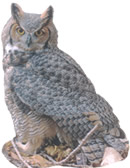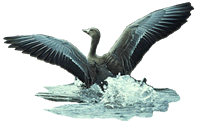




Bird Identification
Wildlife observation can be very rewarding. A silent observer has the opportunity to view moments in a species' life that are not often seen; the hatching of a new bird, a fledgling's first flight, courtship rituals and more.
Salt
Plains Wildlife
Mgmt Techniques
Elements
of Habitat
What
is Mgmt?
Fire
Farming
Moist-soil Mgmt.
Tree Identification
Kids Site Home

The first step in distinguishing between species is to look at the size and shape of the bird. Think about a few species you can identify. Cardinals are small and red. The Bald Eagle is large and is brown with a white head and tail. Scissortail flycatchers are small with 2 long tail feathers. Hummingbirds are tiny and are attracted to flowers.
These are all observations that we make to assist us in identifying those species. Most of us can distinguish between a songbird and a hawk, but can we see the differences between songbirds that crack seeds and those that primarily eat insects?


- FWS Photo


These differences take a little more observation, but are easy to see, once you have trained your eyes to look for the right things.
In learning to identify birds, we will concentrate on differences in size/shape, color, legs/feet and bill shape. You will see how all of these
More Bird
ID!
ID
Training - Bird Quizzes
Birding.com
- More Birding
Ducks
at a Distance -
Duck ID

characteristics contribute to the "why" of the kind of habitat the bird prefers.
Understanding the differences between birds and their specific habitat needs also helps us understand how one bird can become endangered while another one grows in population. Birds have characteristics that are specific to their niche. A niche is the role of an species or population within an ecological community. For example, your niche may be as a teacher, an artist or as a biologist, etc.
Some birds have a large niche; they can live in almost any habitat and can eat a wide variety of foods.
Other birds have a very narrow niche, they can


only live in (ex) old growth forests or will only make nests out of old growth cedar bark. Species with narrow niches have to have an exact balance to survive. Understanding the differences between species opens up a whole world of ecological understanding.
Go to Bird ID: Size/Shape, Color, Legs/Feet, Bill Shape.
- FWS Photo
Wildlife
WebCams
Osprey
Great Horned Owl
NY Bald Eagle
MA Bald Eagle
Squirrel Webcam